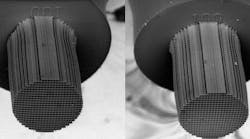Lawrence Livermore National Laboratory (LLNL) researchers have improved the capabilities of two-photon lithography (TPL), a high-resolution 3D printing technique capable of producing nanoscale features smaller than one-hundredth the width of a human hair.
TPL typically requires a thin glass slide, a lens, and an immersion oil to help the laser light focus to a fine point to carry out curing and printing photoresistive materials. It can produce features smaller than the laser light spot (less than 150 nm), a scale no other printing process can match. The technique bypasses the usual diffraction limit of other method, as the photoresist material that cures and hardens to create structures (previously a trade secret) simultaneously absorbs two photons instead of one.
Previous techniques built structures from the ground up, limiting the height of objects because the distance between the glass slide and lens is usually 200 microns or less. The improved process puts the resist material directly on the lens and focuses the laser through the resist; this lets researchers print objects multiple millimeters in height. Furthermore, researchers could tune and increase the amount of X-rays the photopolymer resists could absorb, improving attenuation by more than 10 times over commonly used photoresists.
The laser light refracts as it passes through the photoresist material, so researchers had to match the refractive index of the resist material to the immersion medium of the lens in order for the laser to pass through unimpeded. Index matching opens the possibility of printing larger parts with features as small as 100 nanometers.
“Most researchers who want to use two-photon lithography for printing functional 3D structures want parts taller than 100 microns,” says Sourabh Saha, one of the researchers. “With these index-matched resists, you can print structures as tall as you want. The only limitation is the speed. It’s a tradeoff, but now that we know how to do this, we can diagnose and improve the process.”
By tuning the material’s X-ray absorption, researchers can use X-ray-computed tomography as a diagnostic tool to see the inside of parts without cutting them open or to investigate 3D-printed objects embedded inside the body, such as stents, joint replacements or bone scaffolds. These techniques could also produce and probe the internal structure of targets for the National Ignition Facility, as well as optical and mechanical metamaterials and 3D-printed electrochemical batteries.
The only limiting factor is the time it takes to build, so researchers will next look to parallelize and speed up the process. They intend to move into even smaller features and using the technique to build real, mission-critical parts.
